
Get help from our experts 24/7
- Track Order
- Shipping Info

Your cart is empty
Only £85.00 away from free shipping.
Not a member? Join Us
Forgot your password?

Why We're No Longer Using The Name Wandering Jew
Read more posts in The Green Room
What is Tradescantia?
The Tradescantia genus is beautiful, convenient and flexible. If you're often away from home (or just forgetful!), these houseplants are a dream as they like breaks between waterings, and will flourish when they're next given a soaking.
The Tradescantia Zebrina, one of our favourites, has flowing tendrils that'll look fantastic in a hanging pot or flowing down a bookcase.
The Tradescantia Zebrina genus can be found right across the Americas, in woodlands and open fields. They’re ‘scramblers,’ which means they grow long weak shoots around other ‘host’ plants for survival.
Wandering dude
Tradescantia Zebrina ‘Violet’ is a fond favourite, with their soft purple and green teardrop leaves, which grow in abundance along trailing stems. But Tradescantia Zebrina fluminensis, with pink variegation in place of the zebrina’s regular purple/green pattern, comes in at a close second. Both plants have defined fractal patterns, which help relax the mind.
In this blog, we explain why we love this plant family, and why we've decided to use the name 'Wandering Dude,' in favour of the anti-semitic name 'Wandering Jew.'
The History Behind The Name ‘Wandering Jew’
Previously, Bloombox Club titled Tradescantia Zebrina with their common name: 'Wandering Jew.'
We assumed the name referred to the Israelites, sentenced to 'wander' through the desert in search of the promised land until the last member of the original generation (Moses) dies.
But further research revealed ‘Wandering Jew’ to be connected to an apocryphal myth, one that has been used to justify anti-Semitism since at least the 13th century.
The story goes that one of the men who taunted Jesus on his way to be crucified was cursed to walk the Earth until the Second Coming. In the context of the observable Jewish diaspora; the displacement of Jewish peoples from the Southern Levant in ancient times, and subsequent statelessness from anti-Semitic regimes, we are profoundly uncomfortable with using this moniker.
Then What Should We Call It?
Although Tradescantia has other common names, including Spiderwort and Inch Plant, 'Wandering Jew' seems to be the only one that's stuck.
Bloomboxclub spoke to different plant communities about this quandary, and we think we've found a good alternative. The plant was given its name due to its hyper-adaptability and tendency to spread easily and quickly.
Well, all of these qualities apply to the 'Wandering Dude:' the guy who gets around despite infrequent attention, and isn't fussy about where he ends up! We believe that this is a better title, but if any wandering dudes are offended by the comparison, please get in touch!
Tradescantia Zebrina Care & Growth Guide

Since the 'Wandering Dude' hails from Mexico, you can guess that this plant prefers warmer climates. But, the tradescantia zebrina has the ability to withstand different temperatures. Just avoid exposing this plant to frost because there may be no recovery from that.
The 'Wandering Dude' likes moist or slightly moist soil. You can let the soil dry out between waterings with some frequent mistings ( especially during winter ).
Once your Tradescantia Zebrina starts growing, you might need to do some pruning. You can cut long vines that have missing leaves or those that just getting too long.
We love this beautifully-patterned trailing plant at Bloombox Club. Tradescantia plants are survivors. They can be pushed right to the brink of desolation and then, with some emergency TLC, be brought back to full health within days. They’re a great reminder that life fluctuates and things can get better.
Varieties & Similar Plants
Let’s get into Bloombox Club’s fave 'Wandering Dude' variant, the Tradescantia Zebrina 'Violet' ! Its colourful foliage features hues of silver, purple and green. Beautiful, sturdy, and a super-fast grower, it’s easy to see why we love it so much!
The Tradescantia Zebrina gets its name because it has leaves that look like the stripes of the zebra! It grows tall and can often be used as ground cover for outdoor gardens.
One of the prettier variants of the ‘Wandering Dude’ is the Tradescantia Blossfeldiana . You can find them blooming blue, purple, white, or rose-pink flowers with proper care.
If you’re looking for other indoor plants other than ‘Wandering Jew’ variants, check out our list! ‘Wandering Jews’ make excellent indoor plants, and there are lots of others you can get to build your very own indoor oasis!
Frequently Asked Questions
What is the meaning of the name wandering jew.
The name ‘Wandering Jew’ is from a myth. It was the name given to the man ( a Jew ) who taunted Jesus on the way to crucifixion.
What Is The New Name For A Wandering Jew?
We have opted to call it the ‘Wandering Dude’ plant. You can also call it by its other name, such as Tradescantia Zebrina, Tradescantia Blossfeldiana, Tradescantia Sillamontana or Tradescantia Spathacea, to name a few.
Is Moses In The Cradle The Same As Wandering Jew?
No, they’re not! With such similar Biblical names, you might think that they’re the same plant, but no! They do belong in the same family, Commelinaceae. Moses in the Cradle can alos be referred to by its other names, such as boat lily, cradle lily, or oyster plant.
Where Does Tradescantia Zebrina's Name Come From?
When you look at this plant, it’s easy to see how it got its name - its zebra-like leaves! The Tradescantia Zebrina also features leaf nodes along its stem are about one inch apart. It is one of the more popular types of the ‘Wandering Jew’ or, in our case, the ‘Wandering Dude’ plant.
Is Tradescantia Zebrina An Indoor Plant?
They are and they make terrific indoor plants. They can be hung from a hanging pot or planted in any pot of your choice. They are beautiful, but known to be quite sturdy and not at all needy, so they’re great plants to have at home.
- Shipping and Refund Policy
- Privacy Policy
- Terms of Service
What are you looking for?
Opinion: A grassroots effort is needed to rename this plant
My daughter and I walked through the local garden center trying to find a plant we had admired on a front porch in our neighborhood. It had beautiful magenta and blue-green leaves that spilled from a hanging basket. We wanted to ask for assistance but couldn’t possibly have the name right.
"I think it’s called The Wandering… no that can’t be it, can it?"
Neither of us wanted to complete the name that kept popping into our heads. It sounded wrong – offensive even. However, a quick Google search on our phones confirmed we had the correct common name – The Wandering Jew plant. Its scientific name is tradescantia zebrina.
As we become more culturally aware of how damaging inappropriate mascots are in sports, it only makes sense that we’d notice racist labels in other areas as well. Many online plant and garden communities have taken to calling tradescantia zebrina "The Wandering Dude."
The good news is there are no rules when it comes to common names for plants, and some plants have many. Tradescantia zebrina is a spiderwort that is also known as an inchplant. But if you want to find it at Home Depot or Lowe’s you’ll have to search for it on their websites as "The Wandering Jew."
Scientists tend to not like common names because they want identification to be more specific. Dr. Maggie Whitson, associate professor of Botany and director of the John W. Thieret Herbarium for Northern Kentucky University, explains: "Countries that many of these common names came out of were predominantly Christian, so people were educated in the Bible, they had read the Bible, and had heard Bible stories. So when you attached one of those stories to a plant name, it was a common point of reference and a picture immediately came to mind."
Names based on legend became popular because they quickly communicated a dominant feature of the plant. Such is the case with tradescantia zebrina.
"Really, the important part of the name is the 'wandering' part because it’s a viney spreading plant," says Dr. Whitson.
The Christian legend of the "The Wandering Jew" does not exist in the Bible, but instead first appeared when a medieval English chronicler told the story of an Armenian man who claimed in 1228 to be Pontius Pilate’s doorkeeper. The story says he was cursed to wander the earth until the Second Coming because he claimed to have punched Jesus on his way to Calvary. According to Britannica.com, the legend became popular again in the early 1600s when anti-Semitism was on the rise. A German pamphleteer updated the story with a recent sighting of "The Wandering Jew." The pamphlet was then translated into many languages with more sightings of this cursed individual surfacing. He was even reported seen in Salt Lake City, Utah, in 1868.
As for the botanical side of this legend, I found reference to plants with this common name in horticultural books dating back to the 1830s. Dr. Whitson says, "The nice thing about common names is, because there really are no rules, there’s no reason why you can’t change one if you don’t like it."
That’s exactly what’s happening at the grassroots level in online plant communities. We just need big-box garden centers to grow with the times and sell tradescantia zebrina as "The Wandering Dude."
Bonnie Jean Feldkamp is a member of the Enquirer editorial board and media director for the National Society of Newspaper Columnists. Find her on social media @WriterBonnie or email her at [email protected].
Racism in Taxonomy: What’s in a Name?
Inequities run deep in the natural sciences, and it’s apparent in the racist and xenophobic nomenclature of some trees and plants. Even within the last 30 years, anti-Black slurs were commonly used to describe plants. There are many examples, including Echinocactus polycephalus and Bertholletia excelsa (Brazil nuts), that carry ugly colloquial names that only recently fell out of common usage. Sometimes the racism in a name can even be noted in the scientific nomenclature. The species name for many plants native to South Africa, like Erythrina caffra ( African Coral Tree), has its roots in a slur for the region’s Black communities.
There are also plant names with offensive origins that aren’t as obvious. Tradescantia zebrina, for example, is currently called “Wandering Jew.” This name is based on a fictional character who was used to support antisemitism from the 13th century through the Nazi propaganda of WWII. “Why would we continue using that?,” you may be asking. It’s possible that the covert nature of its history has allowed the name to stick around for so long. People may unintentionally justify the name through assuming it has Biblical or geographical origins, or just by not asking questions altogether. Better names for Tradescantia zebrina are Wandering Spiderwort, Variegated Spiderwort, and Wandering Dude!
Another plant name that flies under the radar is the Pinus sabiniana, or “Digger Pine.” This tree from the western United States is named for a pejorative term used to reference the Paiute and other Indigenous groups. The name is still so commonly used that, without context, one may not think to question its origins. Instead, Pinus sabiniana should be called Gray Pine or California Foothill Pine, which this writer would argue are objectively better names for the conifer, anyway.
How do these names even come to be? The legacy of botany, the natural sciences, and “Western” society itself is rooted in colonialism and exploitation. Knowledge from the mouths of white, Christian men has historically been upheld as unbiased, basic truth, while the Black and Indigenous communities that have been exploited for knowledge and resources on former European colonies are, as Alexandre Antonelli of the Royal Botanic Gardens at Kew put it, “unnamed, unrecognised, and uncompensated.” It’s no wonder that many of the names we encounter in botany are problematic, when they were established with little respect for the humanity of communities that fell outside of a set of exclusionary norms.
Education is a core value of Hoyt Arboretum Friends (HAF), and it’s important to us that we 1) educate ourselves on the role gardens play in upholding systemic inequities, and 2) use our specialized knowledge to help create safer spaces for members of Black, Brown, and otherwise marginalized communities. “ Decolonizing botanical collections,” as urged by Antonelli, is just one way to address exploitation, racism, and other power imbalances. I hope this post empowers you to question the history of the plants and gardens you encounter. This includes Hoyt, too; we’re keeping our eyes out for examples of insensitivity in our own collections and practices, so don’t hesitate to call us in if you notice anything. Get out there and start asking questions, and if you learn something interesting, feel free to let us know!
About the Author

Get JTA's Daily Briefing in your inbox
I accept the JTA Privacy Policy .
By submitting the above I agree to the privacy policy and terms of use of JTA.org
Why this Houseplant is Called the Wandering Jew
Have you watered your Wandering Jew? As you may know, the popular spiderwort ( tradescantia ) is a convenient and flexible houseplant—it can be planted in soil or set to hang in a pot, and it’s very patient with forgetful owners . Its name calls to mind Moses and the Israelites in the Sinai Desert, wandering for 40 years.
But the plant’s name actually refers to a more recent, and sinister, legend of a Jew who scoffed at Jesus en route to his crucifixion. The story isn’t actually canonical —the earliest versions appeared in the 13th century , and were popularizied in the 17th century in by a pamphleteer named Ahashver. (Interestingly, this name is derived from Ahasuerus, the Persian king of the Purim story .)
This motif of the wandering Jew also took form as an 1844 French novel , opera, and silent film which weren’t anti-Semitic so much as straight-up depressing: A Jewish man is separated from his sister by the Bering Strait and condemned to wander the Earth forever. A plague of cholera follows in his wake, and—spoiler alert—he never finds his sister.
Pretty heavy legacy for a houseplant.
__ Watch the silent film, The Wandering Jew :
Recommended from JTA

Celtics win title, but Jewish ‘NBA Countdown’ host Malika Andrews is Finals’ breakout star

‘Suffs’ creator Shaina Taub cites Jewish text in Tony Awards acceptance speech

Lena Dunham and Stephen Fry take a father-daughter trip to Auschwitz in tragicomedy ‘Treasure’

Why Israel was the first country to get its own version of ‘Who is Taylor Swift?’ bestselling kids book

As MLB veteran Kevin Pillar enjoys a late-career resurgence in LA, he’s come to appreciate his place as a Jewish baseball star

LA’s Academy Museum to revise exhibit on Jewish founders after criticism from Jewish Hollywood figures
You are using an outdated browser. Please upgrade your browser to improve your experience.
We use cookies to help us understand how you use our website so we can improve your experience. Visit our Website Privacy Statement or our cookies page .
Tradescantia
Tradescantia is a succulent, brittle weed that can easily break and fragment.
Botanical name: Tradescantia fluminensis
Family name: Commelinaceae
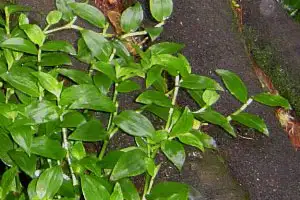
Tradescantia.
Tradescantia is more correctly known as wandering Jew in New Zealand, but as this name is considered offensive to some people, it has been decided to call it tradescantia on this site. Some in New Zealand have decided to call it wandering willie, though many organisations within this country have now moved to the name of tradescantia to get away from the offensive nature of the official name.
Tradescantia is a succulent perennial plant that is an environmental weed, causing major problems under trees and in bush reserves throughout the North Island in some parts of the South Island. Originally from South America, it has been grown as an ornamental garden plant for many years and also in hanging pots, but the sale in garden centres is now banned because of its invasive nature.
Tradescantia can form thick mats of vegetation in moist, shady areas within bush reserves, it stops new seedlings of trees and shrubs from establishing wherever it grows. Although it is not thought to produce seeds within New Zealand, it spreads due to the brittle nature of its stems, resulting in the plant fragmenting easily, and these fragments do not dry out easily.
It probably spreads mainly during periods of flooding, when it gets washed into new areas. It also gets into new areas through people dumping garden waste on roadsides, as it is commonly found in many gardens, especially where gardens have been growing for many decades.
Apart from being a major problem within bush areas and shady gardens, it can cause allergic skin reactions in dogs and other animals running through the foliage. It is also exceedingly difficult to get rid of once established.
Distinguishing features

Tradescantia leaves and flower.
The succulent, brittle nature of the stems distinguishes it from a number of other species that grow on shady forest floors such as periwinkle ( Vinca major ) and ivy ( Hedera helix ).
Each leaf is oval-shaped, shiny, smooth and slightly fleshy with pointed tips. When growing in a mat, this can get 50 cm deep at times. It produces white flowers about 2 cm across in spring to early summer, with each having three petals, whereas periwinkle has blue flowers.
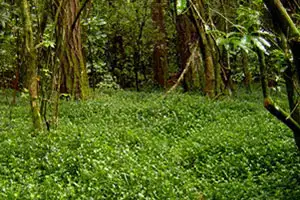
Tradescantia covering ground beneath trees.
Most herbicides give very poor control. The best chemical appears to be triclopyr, which is sold under such trade names as Grazon, Eliminate, Scrubcutter and in garden centres as Hydrocotyle Killer. Even with this herbicide, re-treatment may be necessary.
Amitrole has been used in the past, and although this works better than glyphosate, it is not as effective as triclopyr. Likewise, metsulfuron has some activity on it but is a less effective herbicide. However, triclopyr is mainly used for controlling scrub weeds, so be careful not to spray it on nearby shrubs.
Some people have attempted to rake the plant up under hot dry conditions rather than use herbicide, but this seldom works as any fragments left behind will regenerate, and the raked material has to be disposed of carefully so it doesn’t spread to new areas.
Picloram gel (Vigilant) has sometimes been applied to it with a paint roller, but this cannot be recommended as the persistent picloram residues can be taken up by the roots of trees and shrubs growing underneath the treated weed and cause severe damage to these trees and shrubs.
Similar species
Cleavers have foliage and fruits with tiny hooks that can cling to surfaces.

Great bindweed
Great bindweed is a vine that produces heart-shaped leaves and large white flowers.
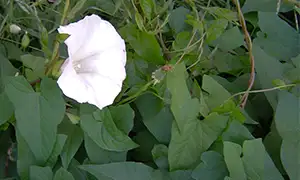
Ivy is a vine-like weed very commonly found in gardens.
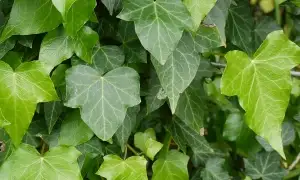
Wisconsin Horticulture
Division of Extension

Purple Heart, Tradescantia pallida
- Share on Facebook
- Share on X (Twitter)
- Share via Email
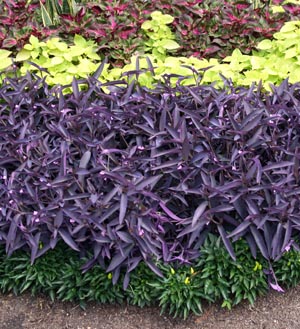
Ask Your Gardening Question
If you’re unable to find the information you need, please submit your gardening question here:
Featured Articles by Season

Latest Horticulture News
- Upcoming Online Gardening Programs Focused on Pollinators
- Plant Diseases: Sometimes the Best Medicine is No Medicine
- How to Deal with Surface Tree Roots
- Spring is Tick Season in Wisconsin
You May Also Like

We teach, learn, lead and serve, connecting people with the University of Wisconsin, and engaging with them in transforming lives and communities.
Explore Extension »
Connect with your County Extension Office »

Find an Extension employee in our staff directory »

Get the latest news and updates on Extension's work around the state

Feedback, questions or accessibility issues: [email protected] | © 2024 The Board of Regents of the University of Wisconsin System Privacy Policy | Non-Discrimination Policy & How to File a Complaint | Disability Accommodation Requests
An EEO/AA employer, University of Wisconsin-Madison Division of Extension provides equal opportunities in employment and programming, including Title VI, Title IX, the Americans with Disabilities Act (ADA) and Section 504 of the Rehabilitation Act requirements.

Tradescantia Tricolor Care From A to Z
By: Author Daniel
Posted on Last updated: July 15, 2021
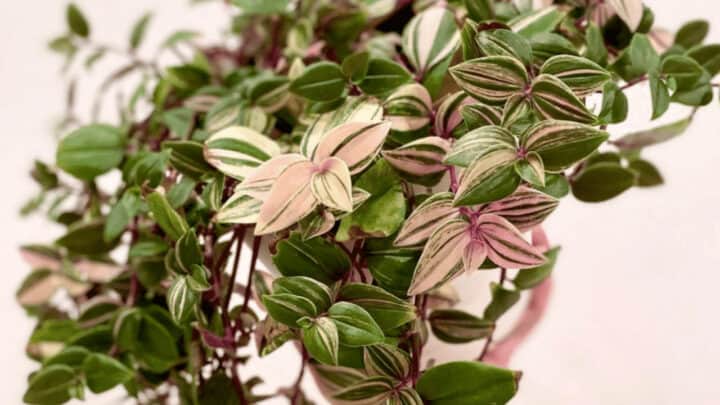
Sharing is caring!
- Facebook 11
(image credits, IG: oohyouplantsy )
I have a hide-away in my home that I escape to for some me-time. It is ultra-feminine and all done out in pink.
When I saw this stunning pink Tradescantia Tricolor plant at the nursery, I just had to have it! It offers the most glorious shades of pink transforming into a darker purple, interspersed with green.
Like all plants, the Tradescantia Tricolor has a difficult Latin Name. This one is Tradescantia fluminensis.
It is also known by other names including the Wandering Jew , Flowering Inch Plant, Wandering Willie, Wandering Gypsy, Purple Queen, Spiderwort, and Tradescantia.
What’s more, Tradescantia is a genus of 75 species of wildflowers. The name comes from John Tradescant, a botanist who lived during the 17th century.
The ‘wandering’ word refers to the fact that it spreads easily, wandering all over your window sill. They are very easy to grow at home. Most are native to South America where they grow as dense mats underneath forest trees.
To enhance the glorious pink shades, I place my Tradescantia Tricolor next to a Mosaic Plant , Fittonia albivenis. This is a trailing plant with deep pink veins in the green leaves. They make a great pair.
Let’s take a closer look at how to care for your Tradescantia fluminensis .
Table of Contents
Tradescantia Tricolor Care
For ideal Tradescantia Tricolor care, give it well-draining soil that will partially dry out between waterings. Fertilize with a good mix of peat, compost, mulch or humus, bark, pumice, or perlite. It thrives best in temperatures between 65°F to 75°F (18°C to 24°C). Temperatures should not drop below 50°F (10° C). The Tradescantia Tricolor wants bright light but not direct sunlight. Placing it near to a south-facing window is ideal.

Tradescantia fluminensis enjoys moist soil to thrive best. However, it must not be drenched or allowed to dry out completely.
Plant it in well-draining sandy soil. You can achieve this by mixing perlite into regular potting soil. Use a mix of 40% perlite and 60% potting soil.
Ensure that your pot has drainage holes at the bottom. This allows the excess water to run out and won’t cause the roots to become waterlogged and drown.
For ideal Tradescantia Tricolor care, I use natural organic additives. Including everyday materials like pumice or crushed bark, sterile garden compost, mulch, or organic manure gives you a rich, fertile soil that makes your Wandering Jew flourish.
Adding in some environmentally friendly coco Husk chips is a great way to introduce extra aeration into the soil. The Tradescantia Tricolor is not fussy about PH levels, try to maintain a neutral PH of around 7.0.
Tradescantia Tricolor does best in bright conditions with indirect sunlight. Allowing direct sunlight to fall onto the plant for too long causes the leaves to scorch.
Too little sunlight results in the leaves fading and not producing those lovely pinky shades.
Try to place your plant about 3 feet away from a south-facing window (if you are in the northern hemisphere), on a side table or high shelf. In this way, it gets the benefit of bright light but not direct sunlight. In general, 45 minutes of direct sunlight will be enough.
If you do need to stand it on a window sill, try to place a sun filter over the window. You can also use your décor skills and get it to nestle under another plant with large leaves, creating a natural umbrella.
If you prefer to plant your Tradescantia Tricolor outdoors, find a spot that gets bright light and limited direct sunlight.
Care tip for Tradescantia Tricolor: If your plant does not show healthy signs of variegated growth, ie, it is not displaying lovely different pink colors, it is probably getting too little light.
When it comes to watering care for your Tradescantia Tricolor, it is best to keep the soil moist. You need a balance between drenched and bone dry.
Watering once a week during the summer months is adequate. In winter, reduce watering to once every two weeks.
Because you are not drenching this plant, you should not create too much of a mess indoors. Place a plant saucer under your pot that is large enough to catch any water that may flow out.
When watering in winter, use lukewarm water, no plant responds well to an icy blast! I do notice that my Wandering Jew can get to the point of looking almost droopy. Then a good watering brings it back to life within 24 hours.
Tradescantia Tricolor care tip: You can also water from the bottom. This technique involves placing your pot into a tub or sink filled with a few inches of water. The drainage holes in your planter allow the water to slowly absorb into the soil without over-saturating it.
Temperature
Tradescantia species perform best at temperatures ranging from 65°F to 75°F (18°C to 24°C). They can, if necessary, withstand higher temperatures. If the temperature drops below 50°F (10° C), the leaves will suffer.
It will tolerate short-term exposure to cold weather but generally does not do well in the cold. If you live in a cold climate, consider growing your outdoor Tradescantia Tricolor in a container.
You can then bring it indoors during the winter months. All species of Tradescantia are Winter hardy in USDA hardiness zones 9 to 12.
Coming from South America, the plant does not require tropical temperatures to thrive. It is quite hardy, and as long as it is not exposed to frost you should be fine. It can even stand on a chillier window sill.
Your Tradescantia Tricolor is not overly fussy about humidity. It is not a desert plant nor a tropical plant, so the average house humidity of 30% to 45% found in a home should do fine.
In winter, running heaters and air-conditioners can dry out the air and change the humidity, so you will need to be aware of this.
If the humidity in your home is too high, at over 50%, this could result in the growth of mold and bacteria and will give your living space a musty smell. Installing a dehumidifier will help to solve the problem.
Tradescantia Tricolor care tip: I find that my plant responds well to a lovely soft shower from a watering can.
Although this does not increase humidity, it acts as a natural rain shower, wetting all the leaves and washing away dust and pests.
Make sure you do this outside and allow the plant to dry off before moving it back indoors.

Fertilizer
The Inch Plant loves to wander and grows fairly fast, spreading over window sills indoors and rocks outdoors. It does not require a serious fertilizing program.
Like many potted indoor plants, Tradescantia fluminensis does well with some extra fertilizer during the growing months of Spring through early fall.
I am a great supporter of eco-friendly living and that also applies to the plant fertilizers I use. I stay away from chemical fertilizers whenever possible.
My number one care hack for Tradescantia fluminensis is to buy or make my own natural organic fertilizer. If you have a liquid fertilizer, dilute it, and use it once a month.
Fertilizing plants outside of the growing season is not good. The fertilizer can end up harming the plant by burning the roots.
Natural organic fertilizers can be made using peat, pumice, perlite, mulch, coco husks, and crushed bark. A small compost making kit is a fun addition to any garden and makes good use of fallen leaves, dead flowers, and grass cuttings.
Propagation
The easy-to-grow Inch Plant is also easy to propagate. This can be done by simply snipping off a healthy stem, placing it into rich, moist soil, and watering from time to time.
You can also put the stem cutting into a tall vase of water and allow it to grow roots. Place the vase in a bright spot and keep an eye on it.
Roots will appear within a week. Remove the cutting and plant into your terracotta pot or unglazed planter.
Propagating your own house plants is a fun and rewarding experience, give it a try!
Tradescantia Tricolor gets its Wandering’ name because it loves to wander. It grows fairly fast and spreads over the edge of pots, along window sills, and over rocks. It also looks great as a ground cover next to pathways and walkways in a garden.
It has beautiful variegated pink shades, that darken to purple and are interspersed with green. The stems and leaves are soft and hairless.
The leaves are an oval shape with pointed tips. They are shiny and smooth and grow to about 1.25 to 2.5 inches (32 to 64mm) long.
The flowers are white and have 3 petals, about 0.5 to 1 inch (13 to 25mm) in diameter. The flowers appear in Summer in small clusters.
The best Wandering Jew growing condition is in a bright spot with indirect sunlight and average humidity.
This plant is a ground cover perennial. It does not require heavy pruning, but if it sprawls too much and becomes straggly, you should trim it back to keep it in shape.
Tradescantia fluminensis care tip: If your plant is producing only green leaves, your light conditions are not ideal.
It does this to conserve energy, as creating variegated leaves uses up more energy. Prune back the green leaves, allow it to recover and produce those glorious pink shades.
Tradescantia fluminensis is not fussy when it comes to pot size. It will thrive in a small pot for years and will grow happily in a large pot.
If you do want to repot your Inch Plant, Springtime is the best season to do this. Repot into a mix of fresh soil and perlite to boost growth.
You can add some gritty sand to the potting mix to enhance drainage. Water well but do not drench. Check that the PH of the soil is neutral at around 7.0.
Care tip: Ensure that your planter has drainage holes so that the water can flow out. You don’t want the roots to rot in stagnant water at the base of the pot.
Sieh dir diesen Beitrag auf Instagram an Ein Beitrag geteilt von D A I S Y (@oohyouplantsy)
Propagate Tradescantia Tricolor from cuttings
– This is best done in early Spring to late Summer, during the growing period
– Use a sterile sharp knife, scissors, or cutter
– Wear gloves as the sap can irritate the skin
– Select a stem that looks healthy and has a few sets of leaves
– Carefully cut off the stem at the base, where it joins another stem
– Remove the lower leaves by snipping off to leave a clean stem at the base
– You now have 2 options: propagate in soil or propagate in water
Propagating the cuttings in soil
– Prepare a pot with a mix of soil, gritty sand, and organic fertilizer
– Water well but don’t drench
– Push your finger into the soil and create a hole about 2 inches deep
– Place the offcut into the soil and pack the soil back to hold it firm
– Place the planter where it will get bright light but not direct sunlight
– Water well for the next few weeks
Propagating the cuttings in water
– Fill a clear vase, tall glass, or container with water
– Place the cutting into the water
– Keep it shallow enough so that the leafy section is above the waterline
– A slender glass works well as the leaves will balance on the top rim
– Fine roots will start showing in about 1 to 2 weeks
– Wait for the roots to grow to 1 to 2 inches long
– Plant into a pot as described above
Common problems with Tradescantia Tricolor
Pest control.
Like all plants, your Tradescantia Tricolor can be attacked by pests. Common pests that affect the Wandering Jew are spider mites and aphids .
An easy way to get rid of them is to give your plant a good shower and wash them off. If they persist, you can spray with a solution of insecticidal soap.
Tradescantia Tricolor care tip for pests: Make your own insecticidal soap. Use all-natural soap, not detergent.
Mix 5 tablespoons to 1 gallon of cooled, boiled water. Add in 1 teaspoon of vinegar and 1 teaspoon vegetable oil to get the solution to stick. You can also add a teaspoon of garlic. Pour into a clean garden sprayer that has a fine spray setting and spray the plant.
Leaves don’t have variegated colors
If you notice that your Tradescantia Tricolor is only producing green leaves, this is due to bad lighting. Bad lighting reduces the energy of the plant.
To create the gorgeous colors, it needs energy, so it will conserve energy and only create green leaves.
Leaves look scorched
If your leaves are turning brown or look scorched, your plant is getting too much direct sunlight. Move it to a more suitable position, or protect it with sunscreen if possible.
Plant looks scraggly and untidy
Tradescantia Tricolor grows fast and spreads. You need to keep it in shape by trimming now and then. Remove any dead stems and leaves. Trim back into the neat shape you want.
Rotting roots
This is a sign of too much water. Tradescantia Tricolor does not enjoy drenched soil. Ensure that your container has drainage holes and allow the soil to partially dry out.
Tips to grow Tradescantia Tricolor problem-free
– Avoid overwatering your Tradescantia Tricolor
– Keep soil moist but well-drained
– Ensure that your plant is in a bright spot, it does not enjoy the dark
– Do not place in direct sunlight
– Does not enjoy very dry or very humid conditions
– Fertilize during the growing season with organic mixtures
– Trim from time to time if it becomes scraggly
Frequently asked questions about Tradescantia Tricolor
Is tradescantia tricolor considered invasive .
In some countries, Tradescantia Tricolor is invasive. This is because it spreads fast outdoors and can become invasive. It grows as thick mats in forest areas, blocking out the light for other ground plants.
Can Tradescantia Tricolor grow indoors?
Yes, it makes a very attractive indoor plant in a decorative pot. It looks fabulous in a hanging basket, or on a high shelf where you can let the long stems flow downwards.
Is Tradescantia Tricolor easy to care for?
Yes, this is a great plant for beginners. It requires very little maintenance and is hardy and strong. You don’t want to be discouraged by losing your first plant. The Tradescantia Tricolor will flourish in a bright spot out of direct sunlight.
Is Tradescantia Tricolor poisonous?
Do you want a glorious plant with pink tones? The Wandering Jew is eye-catching and easy to care for. It is a great choice for a beginner to create a focal point in a room or on a patio, in a hanging basket.
Once you are successful in growing your Tradescantia Tricolor, you can add other Tradescantia plants to your collection. Take a look at the lovely Tradescantia occidentalis, Tradescantia zebrina, and the Tradescantia pallida.

Daniel has been a plant enthusiast for over 20 years. He owns hundreds of houseplants and prepares for the chili growing seasons yearly with great anticipation. His favorite plants are plant species in the Araceae family, such as Monstera, Philodendron, and Anthurium. He also loves gardening and is growing hot peppers, tomatoes, and many more vegetables.
Related Posts
You are reading this guide to learn more about the Wandering Jew Plant and its…
I love plants that offer an eye-catching burst of color. They sure put a smile…
Tradescantia Nanouk is not difficult to care for if you keep in mind its basic…
Are you looking for a care guide for Anthurium Andraeanum? The Flamingo flower is a…
Among my favorite houseplants is NJoy Pothos, the one that sparked my interest in having…
Several Calathea species are highly valued as houseplants, such as the Calathea Zebrina…
- Growing Houseplants
- Indoor Garden Ideas
- Cactus & Succulents
- Houseplants Care
- Flowers & Blooms
- Gardening Guide
- Plant Care and Tips
- Beans/Fruit Vegetables
- Companion Planting
- Culinary Herbs
- Flowering Herbs
- Garden Design
- Gardening Ideas
- Growing food
- Growing Trees and Shrubs
- Leafy Vegetables
- Medicinal Herbs
- Patio Gardening
- Root Vegetables
- Shade Plants
- Temperate Fruits
- Tropical Fruits
- Balcony Gardening
- Container Fruits
- Container Gardening Ideas
- Container Herbs
- Container Vegetables
- Rooftop/Terrace Gardening
- Urban Gardening
- Vertical Gardening
- More Than Gardening
- Best and Top of Gardening

- Container Gardening
- Indoor Gardening
Leggy Wandering Dude? 6 Ways to Fix It

2-Minute Read
Do you have a leggy wandering jew plant and want to know how to fix it this article is just for you.
You may notice leggy growth in your Wandering Dude plant for various reasons. Before it gets worse, learn how to make it lush and colorful again with these tips.
What is a Wandering Dude?
Wandering Dude is the common name for different varieties of Tradescantia zebrina, a species of fast-growing creepers that like to … wander!
When left undisturbed outdoors, these vining plants can become quite invasive, colonizing new areas and slow-growing vegetation. However, their zebra-patterned leaves in silver, green, and magenta make them wonderful houseplants.
Why Is My Wandering Dude Leggy?
Also called the Inch Plant, it sometimes grows with skinny, elongated stems but barely any leaves. The plant becomes leggy for reasons that differ according to the growing conditions and environment.
Some of the key causes include insufficient light, incorrect watering, and a lack of essential nutrients. This drifter stretches out in the hope of finding these resources for self-sustenance.
Let’s take a look at what could be bothering your wandering dude and how to fix it!
How To Fix A Leggy Wandering Dude
1. fix the lighting condition.
Insufficient light is a number one culprit for leggy growth, where the stems stretch out with far fewer leaves. Here’s how to give your plant the light it needs to flourish.
Aim for bright, indirect light for at least 6-8 hours daily. Think of a spot near any bright window. If it’s south-facing, keep your plant far from intense sun exposure.
This will provide ample light for healthy growth without the harsh intensity of direct sunlight. Direct sun, especially during the afternoon, can scorch the leaves, so, again, avoid west—or south-facing windows or keep the plant slightly away.
If your house doesn’t have sufficient natural brightness, you can use a grow light.
2. It could be a Watering Issue
Both overwatering and underwatering can stress your plant, affecting its stable growth and making it leggy. However, it’s mostly consistent overwatering in the majority of cases!
Establish a consistent watering routine that keeps the soil evenly moist but slightly around your leggy wandering dude. A simple rule is to water the plant when the top inch of the soil feels dry so that it doesn’t waterlog; a good way to find it is by inserting your finger before saturating. During winter, reduce the frequency of watering as the plant’s growth slows down.
Also, determine the frequency of watering according to its growing conditions. For example, if your tradescantia zebrina is placed in a shadowy spot with little air circulation, water less frequently. If your plant is exposed to a mix of direct and indirect sunlight with good air circulation, water more often!
3. Proper Fertilization

This native of Mexico and Central America thrives in rich, well-draining soil. So, if it appears leggy and weak due to insufficient nutrients, try revitalizing your moribund plant with a water-soluble fertilizer at least twice a month during its active growing season.
Use a fertilizer that contains nitrogen, phosphorus, and potassium in equal proportions. Dilute this aqueous mixture to a quarter or half its recommended strength to prevent the leaves from getting burnt.
During fall and winter, reduce feeding frequency as the plant stops growing vigorously.
4. A Temperature too High or too Low
The wandering dude feels at home in tropical and temperate climates, preferring warm weather and humidity. Sudden fluctuations stress the plant out, leading to leggy growth. A consistent temperature range between or around 60-75°F (15-24°C) will ensure healthy growth.
While this tough plant can tolerate extreme temperatures below 32 F (0 C) and above 100 F (38 C) for a while, it’s best to maintain a steady range. Start caring for your tradescantia when your thermometer dips below 50 F (10 C) or hits over 85 F (29 C).
Avoid placing the plant near drafts, heaters, or air conditioners. You can also use a thermometer to monitor the temperature around your plant and make adjustments as needed to ensure a stable environment.
This nomadic species mostly cannot tolerate frost; this is why if you live in a cold climate, it’s best to overwinter it indoors.
5. Maybe it is Rootbound

Famous for its aggressive growth, at some point, your wandering dude will likely outgrow its container , making it root-bound and hindering its nutrient uptake, thus making it leggy. Simply re-pot to a larger, spacious container with a well-draining, organic-rich potting mix to promote a lush growth habit.
If you want to utilize the same pot again, divide the rootball of your mother plant into 2 to 4 portions, providing each section enough roots and top growth equally, and plant them back in separate pots. It’s a nice way to have more of this amazing plant in your home .
6. Aging causes Leggy Growth
If your wandering dude becomes scraggly and lanky, it’s clearly time for a good haircut, as it can be due to aging; old growth in this popular plant often loses lackluster, and a strategic prune may help put back the bounce in your dude.
Identify the stems that are old and aging, excessively long or sparse, and make clean cuts just above a node (the point where leaves attach to the stem). This will help stimulate the plant to produce new shoots and leaves from the node, leading to fuller foliage.
Don’t forget to sterilize or thoroughly clean your pruning shears to prevent disease transmission, and read our comprehensive post that will guide you on growing a bushier wandering dude .
If you follow these steps, your wandering dude will come back to life handsome and happy! Don’t forget to share your own stories with this roving plant via the comment section below!
Recent Posts
Wandering jew leaves fading 5 tips to make it colorful again, cactus corking: 7 reasons why your cactus turns brown and solutions, 26 fruits in shade | best fruits that grow in shade, 11 herbs you can grow from fresh softwood cuttings, 10 best plants that attract fireflies, the more you cut these 9 flowers the more they bloom, 8 berries that look like strawberries, 12 fruits you can grow indoors as a houseplant, join our 3 million followers:, related articles, 4 secret tips to rescue a dying pothos, you’ve been growing tomatoes all wrong before this is how it should be, 10 air plant care tips you should know, snake plant leaves turning yellow 9 reasons and solutions, 7 problems with roses in pots and their solutions, leave a reply cancel reply.
Save my name, email, and website in this browser for the next time I comment.

Get the Best of BalconyGardenWeb Directly in your inbox.
POPULAR CATEGORY
- Best and Top of Gardening 1626
- Flowers & Blooms 679
- Growing Houseplants 599
- Gardening Guide 416
- Gardening Ideas 388
© 2023 Balcony Garden Web | All rights reserved
- Privacy Policy
- Terms of Service
- Feedback Page
- Newsletters
- Publications
- County Offices
- Distance Ed
- Staff Directory

- 4-H Forestry
- Youth Livestock
- Youth Poultry
- 4-H Shooting Sports
- Health and Wellness
- Ambassador Program
- Collegiate 4-H
- Disaster Response-Youth
- Keys to the Community
- SAFETY Ambassador Program
- Join 4-H Robotics Club
- Support 4-H
- Wildlife Youth Education
- Youth Horse
- Youth Projects
- Bost Conference Center
- County Extension Offices
- Centers and Institutes
- Comprehensive Department Heads
- Research and Extension Center Heads
- Regional Extension Coordinators
- Extension Administrative Council
- Extension Leadership Council
- Extension Matters Magazine
- Program and Staff Development
- Research and Extension Centers
- Undergraduate Apprenticeship Program
- Agricultural Economics
- Catfish Marketing
- Catfish Water Quality
- Harvesting, Loading, and Transport
- Nutrition, Feeds, and Feeding
- Freshwater Prawns
- Hybrid Striped Bass
- Production Phases and Systems
- Christmas Trees
- Commercial Fruit and Nuts
- Green Industry
- Greenhouse Tomatoes
- Nursery Safety Videos
- Organic Fruit and Vegetables
- Other Vegetables
- Peas and Beans
- Tomato Pepper and Eggplant
- Watermelon Cantaloupe and Cucumber
- Mississippi Boll Weevil Management Corporation
- Insects-Crop Pests
- Master Irrigator
- Plant Diseases
- Sweet Potatoes
- Watermelons
- Weed Control for Crops
- Agri-business
- Growing Your Brand
- Agricultural Engineering
- Biotechnology
- Farm Safety
- Remote Sensing Technology
- Women for Agriculture
- Spray Drones
- Pre-Planting
- Crop Growth Stages
- End of Growing Season
- Safety and Regulations
- Sciences of Remote Sensing
- Types of UAS
- Fertilizers - Forages
- Insects-Forage Pests
- Management - Forages
- Weed Control for Forages
- Animal Health
- Beef Calendar
- Beef Publications
- Cattle Business in Mississippi Articles
- Apiculture: Honey Bee Health
- Goats and Sheep
- Small Animals
- Culinary Tourism
- Farmers Markets
- Local Food System Economies
- Marketing and Business Planning
- Specialty Crop Production
- Pesticide Applicator Certification
- Mississippi Land Resource Areas
- Soil Acidity
- Soil Fertility
- Soil Health
- Soil Testing
- About TCALP
- Advisory Council
- Contact TCALP
- Current Class
- TCALP Frequently Asked Questions
- 2020 Census
- County Elected Office
- Decision to Run
- Campaign Finance
- Voter and Election Information
- Contacts & Resources
- Oil and Gas
- Disaster Response
- Economic Development
- Extension Center for Economic Education and Financial Literacy
- Junior Master Wellness Volunteer
- MS Volunteer Leaders Association
- Master Clothing Volunteers
- Master Gardener
- Mississippi Homemaker Volunteers
- Public Water System Assistance Program
- Rural Development
- Small Business
- MSU Extension Head Start
- Nurturing Homes Initiative
- Mississippi Child Care Resource and Referral
- Equine Assisted Therapy Programs
- Family Dynamics
- Basic Money Management
- Disaster Relief
- Estate and Financial Planning
- Fraud and Identity Theft
- Housing and Homebuyer
- Volunteer Money Mentors
- Youth Financial Literacy
- Creating Healthy Indoor Childcare Environments
- Produce Safety
- AIM for CHangE
- Colon Cancer Screening
- Dining with Diabetes
- Growing Well
- Nutrition and Wellness
- Prescription Opioid Misuse
- Mental Health First Aid
- Farm Stress
- Rural Health
- Forage Pests
- Household Insects
- Human Pests
- Insect Identification
- Insects Vegetable Gardens
- Ornamental Plants
- Cut Flowers and Houseplants
- Floral Design
- Flower Gardens
- Gardening Through the Seasons Video
- Herb Gardens
- Insects-Home Lawns
- Insects-Ornamental Plants
- Healthy Soils and Water
- Landscape Management
- Landscape and Garden Design
- Plants and Wildlife
- Landscape Resources
- Mississippi Landscape Gallery
- Professionals Corner
- Diversity of Plants
- Energy Savings
- Healthy Soils
- Healthy Water Practices
- Integrated Pest Control
- Places for Wildlife
- Fruit and Nut Disease Calendar
- Fruit and Nut Disease Publications
- Fruit and Nut Disease Updates
- Plant Disease and Nematode Diagnostic Services
- Vegetable Disease Calendar
- Vegetable Disease Publications
- Vegetable Disease Updates
- The Story of Plants and People
- Turfgrass and Lawn Management
- Vegetable Gardens
- Weed Control for Lawn and Garden
- Youth Gardening
- Construction
- Pond and Lake Water Quality
- Fish Management
- Weed Control
- Carbon Credits
- Disaster Recovery
- Forest Ecology
- Forestry Impacts
- Timber Prices
- Agroforestry
- Beginning Forestry
- Forest Pests
- Longleaf Pine
- Pine Straw Mulch Production
- Regeneration
- Forest Soils
- Frequently Asked Questions
- Timber Harvest
- Urban and Community Forestry
- Invasive Plants
- Seafood Economics
- Seafood Harvesting and Processing
- Waste Management
- Mississippi Water Stewards
- Mississippi Well Owner Network
- Rural Water Association
- Water Quality
- Water Weeds
- Chronic Wasting Disease
- Northern Bobwhite Quail
- Nuisance Wildlife and Damage Management
- Operation HOG
- Urban and Backyard Wildlife
- White-Tailed Deer
- Wildlife Economics and Enterprises
- Manufacturers
- Testing Abilities
- Treatment and Preservation
- Wood Identification
- Wood Pellets
- Wood Utilization
- Registration Portal
You are here
Spiderwort, purple heart are landscape favorites, information possibly outdated.
The information presented on this page was originally released on September 10, 1998. It may not be outdated, but please search our site for more current information. If you plan to quote or reference this information in a publication, please check with the Extension specialist or author before proceeding.
By Norman Winter Horticulturist Central Mississippi Research & Extension Center
Few people recognize the name, Tradescantia, but most people recognize the specific plant names Wandering Jew,.Moses-in-the-Cradle, Three-Men-in-the-Boat, Moses-in-the-Bulrushes, Spiderwort and Purple Heart, which are all Tradescantia.
Every spring we see the gorgeous blue Spiderwort flowers growing along our roadsides and in our gardens. While some find the roadside flower slightly invasive, others say they are great. Many don't realize that this plant is very closely related to the Wandering Jew.
The native Spiderworts are known as Tradescantia virginia and Tradescantia occidentalis. Most have blue flowers, but there are varieties available with white, purple, rose, red and even double flowers.
The Wandering Jew name really refers to Tradescantia flumensis and Tradescantia zebrina. The name zebrina gives a hint that it does have stripes, but so do some cultivars of the Tradescantia flumensis. Both are native to Guatemala, Honduras and Belize.
This summer my wife, Jan, made hanging baskets with some of the solar coleus growing on top or in the middle, with Wandering Jew hanging down all around. They have really made a show all season.
The Moses-in-the-Cradle, Three-Men-in-the-Boat and Moses-in-the-Bulrushes is known botanically as Tradescantia spathacea. It gets its name from the flowers clumped in a purple boat or cradle-shaped bract.
These are really succulent leaves, and the plants are well suited to hanging baskets, window boxes and anywhere else that it can be allowed to cascade. These are not very cold hardy and will have to be protected during the winter.
Purple Heart, or Tradescantia pallida, is the one that has all the landscapers and horticulturists raving. A lot of catalogues, books and Internet information still refer to it by the name Setcreasea pallida with the common name setcreasea.
A native of Eastern Mexico, this deep-purple, vining plant is very drought tolerant and ideal for landscapes. The color is outstanding when grown with plants like the New Gold lantana. The entrance to Northpark Mall in Ridgeland has some striking plantings with rocks and lantanas.
Another beautiful combination is to plant it with the coral-colored Salvia coccinea or pink verbenas. Another choice combination is with ornamental grasses like Fountain or Muhly grass.
The Purple Heart is perennial in zones 8 and 9 but is still worth planting in zone 7 as an annual. There are many that will say that it dies back in zone 7 but returns faithfully each year with a layer of mulch. Purple Heart prefers a well-drained, organic-rich bed, but is being touted as the plant that will grow just about anywhere it doesn't get wet feet. In fact, root rot is its No. 1 enemy which only occurs in soggy soils.
Since this is a sprawling type plant, we can increase its bushiness by pinching or cutting back the terminal ends of the plant. Purple Heart and Wandering Jew are easy to propagate by stem cuttings. Just stick one in the soil where you need a new plant or two, and keep it moist until roots develop. Then cut back on the water. If you will try Purple Heart you will get hooked like the rest of us, I promise.

Select Your County Office
Your extension experts.

Dr. Shaun Robert Broderick

Dr. Alan Henn

Dr. Blake Layton, Jr.

Dr. James Dewey McCurdy

Mr. Pawel Miroslaw Orlinski

Dr. Barry R. Stewart
Related news, related publications, recent issues.

IMAGES
VIDEO
COMMENTS
Previously, Bloombox Club titled Tradescantia Zebrina with their common name: 'Wandering Jew.'. We assumed the name referred to the Israelites, sentenced to 'wander' through the desert in search of the promised land until the last member of the original generation (Moses) dies. But further research revealed 'Wandering Jew' to be connected ...
Liz Hughes, the co-owner of Groovy Plants Ranch in Marengo, Ohio, switched T. zebrina's name from wandering Jew to wandering dude around 2019 after hearing about the renaming movement ...
"Really, the important part of the name is the 'wandering' part because it's a viney spreading plant," says Dr. Whitson. The Christian legend of the "The Wandering Jew" does not exist in the ...
Tradescantia zebrina, for example, is currently called "Wandering Jew." This name is based on a fictional character who was used to support antisemitism from the 13th century through the Nazi propaganda of WWII. "Why would we continue using that?," you may be asking. It's possible that the covert nature of its history has allowed the ...
Its name calls to mind Moses and the Israelites in the Sinai Desert, wandering for 40 years. But the plant's name actually refers to a more recent, and sinister, legend of a Jew who scoffed at ...
Just when "Wandering Jew" became a name for Tradescantia zebrina, or in what language this first happened (the plant is also known as juif errant in French, hebreo errante in Italian, judío ...
The common name wandering Jew refers both to the wandering habit of several species within Tradescantia, and also to a character from early Christian mythology. Description Flower close up. Tradescantia fluminensis is a perennial groundcover that spreads along the ground with soft, hairless stems and leaves. The fleshy stems root at any node ...
Tradescantia zebrina, formerly known as Zebrina pendula, is a species of creeping plant in the Tradescantia genus. Common names include silver inch plant and wandering Jew. [1] The latter name is controversial, [2] and some now use the alternative wandering dude. [3] The plant is popular in cultivation due to its fast growth and attractive foliage.
The Wandering Jew by Gustave Doré. The Wandering Jew (occasionally referred to as the Eternal Jew, a calque from German "der Ewige Jude") is a mythical immortal man whose legend began to spread in Europe in the 13th century. In the original legend, a Jew who taunted Jesus on the way to the Crucifixion was then cursed to walk the Earth until the Second Coming.
Tradescantia is more correctly known as wandering Jew in New Zealand, but as this name is considered offensive to some people, it has been decided to call it tradescantia on this site. Some in New Zealand have decided to call it wandering willie, though many organisations within this country have now moved to the name of tradescantia to get away from the offensive nature of the official name.
The former name S. pallida or S. purpurea is still often used. Commonly called purple heart or purple heart wandering jew (and occasionally "Moses in the Basket," although this usually refers to a different species) this herbaceous plant in the Commelinaceae (spiderwort family) is a low-growing trailer that is hardy in zones 7-10, but is ...
The Wandering Jew, illustration by Gustave Doré, 1856. wandering Jew, in Christian legend, character doomed to live until the end of the world because he taunted Jesus on the way to the Crucifixion. A reference in John 18:20-22 to an officer who struck Jesus at his arraignment before Annas is sometimes cited as the basis for the legend.
W andering Jew Plant Care. To keep your Wandering Jew plant thriving, ensure it receives bright, indirect sunlight. Keep it in average room temperatures of 60-75°F (16-24°C). Fertilize once a month during spring and summer. In winter, relocate the plant to a cooler area with temperatures of 54-59°F (12-15°C).
The name Wandering Jew has been given to a card game, a game of dice, plants, and birds. The legend has obvious affinities with other tales of eternal wanderers, primarily Cain (with whom the Jewish people as a whole is identified by Christian homilists, beginning with *Tertullian (150-230)).
Like all plants, the Tradescantia Tricolor has a difficult Latin Name. This one is Tradescantia fluminensis. It is also known by other names including the Wandering Jew, Flowering Inch Plant, Wandering Willie, Wandering Gypsy, Purple Queen, Spiderwort, and Tradescantia. What's more, Tradescantia is a genus of 75 species of wildflowers.
Lets Start With its Interesting Name - The Wandering Dude! Not long ago, this plant was famous by the name—wandering jew.However, the "Jew" in it made people confuse, and sorta angry, as it related it to some biblical story. The tale in which a man mocked Jesus when he was on his way to the cross, and that man, then, was cursed to wander the Earth.
Wandering 'Dude'. Tradescantia is one of the most patient and easily cultivated of house plants. Easily propagated and spreading with ease (where the wandering term in its common name comes from). We have called it 'Wandering Dude' here even though many of you likely know it as 'Wandering Jew'. It is likely the Jew moniker originated out of ...
How To Fix A Leggy Wandering Dude. 1. Fix the Lighting Condition. Insufficient light is a number one culprit for leggy growth, where the stems stretch out with far fewer leaves. Here's how to give your plant the light it needs to flourish. Aim for bright, indirect light for at least 6-8 hours daily.
Few people recognize the name, Tradescantia, but most people recognize the specific plant names Wandering Jew,.Moses-in-the-Cradle, Three-Men-in-the-Boat, Moses-in-the-Bulrushes, Spiderwort and Purple Heart, which are all Tradescantia. Every spring we see the gorgeous blue Spiderwort flowers growing along our roadsides and in our gardens.
The controversial name "wandering Jew" originates from the Christian myth of the Wandering Jew, condemned to wander the earth for taunting Jesus on the way to his crucifixion. ... the cells mutate and change color to pink; they are one of the few tissues known to serve as an effective bioassay for ambient radiation levels.
Many, many moons ago, Avery Rowe (ICRA of the Tradescantia genus and founder of Tradescantia Hub) told me about the controversy surrounding one of the common names for Tradescantia, "Wandering Jew".Some moons later (but still many moons ago) I launched a survey to get some statistics on it, so that we could refer to something, anything when we say things like "this name is considered ...
The Wandering Jew plant, also known by its scientific name Tradescantia, is a popular houseplant admired for its striking foliage and easy care. The Wandering Jew is a member of the Tradescantia ...
The Wandering Jew, also known as Tradescantia, is a popular houseplant known for its vibrant foliage and easy-going nature. With its striking leaves that come in shades of green, purple, and ...